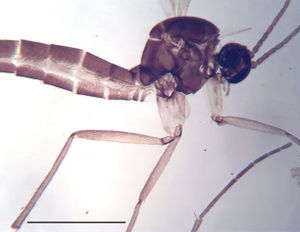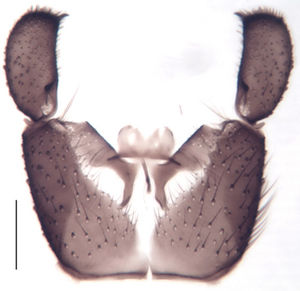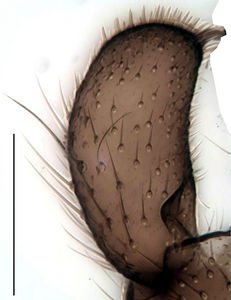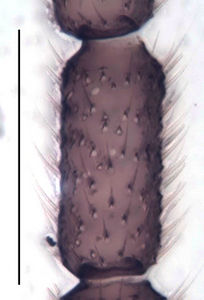Trichosiopsis clavicaudata
Ordo: Diptera
Familia: Sciaridae
Genus: Trichosiopsis
Name
Trichosiopsis clavicaudata unpublished
Type material
Holotype: ♂, 3.7.–9.7.2009, Malaise trap, leg. Barstad, TSZD-JKJ-103828 in TSZD
Type locality
Norway, Finnmark, Vardø, Komagdalen
Barcoded material
| Stadium | Country | Province | Locality | Habitat | Method | Date | Collector | Collection Number | Collection | Latitude | Longitude | Elevation (m) |
|---|---|---|---|---|---|---|---|---|---|---|---|---|
| 1 ♂ (holotype) | Norway | Finnmark | Vardø, Komagdalen, Stuorra Suovka | Malaise trap | 3.7.–9.7.2009 | T. E. Barstad | TSZD-JKJ-103828 | TSZD | 70 | 30 | ||
| 1 ♂ | Norway | Finnmark | Alta, Gargia, along Vinabekken | Malaise trap | 2.7.–10.7.2014 | Jostein Kjærandsen | TSZD-JKJ-103770 | TSZD | 69.84 | 23.4292 | ||
| 1 ♂ | Norway | Finnmark | Alta, Gargia, along Vinabekken | Malaise trap | 2.7.–10.7.2014 | Jostein Kjærandsen | TSZD-JKJ-103771 | TSZD | 69.84 | 23.4292 | ||
| 1 ♂ | Norway | Finnmark | Alta, Gargia, along Vinabekken | Malaise trap | 2.7.–10.7.2014 | Jostein Kjærandsen | TSZD-JKJ-103772 | TSZD | 69.84 | 23.4292 | ||
| 1 ♂ | Norway | Finnmark | Vardo, Komagdalen, Stuorra Suovka | Malaise trap | 3.7.–9.7.2009 | T. E. Barstad | TSZD-JKJ-103829 | TSZD | 70 | 30 | ||
| 1 ♂ | Norway | Finnmark | Vardo, Komagdalen, Stuorra Suovka | Malaise trap | 3.7.–9.7.2009 | T. E. Barstad | TSZD-JKJ-103838 | TSZD | 70 | 30 | ||
| 1 ♂ | Norway | Finnmark | Batsfjord, Komagdalen, `Ovre` Komagdalen | Malaise trap | 3.7.–9.7.2009 | T. E. Barstad | TSZD-JKJ-103871 | TSZD | 70 | 30 | ||
| 1 ♂ | Finland | Lappland | Savukoski, Ahot | Malaise trap | 8.7.–7.8.2014 | Jukka Salmela | ZFMK-TIS-2507890 | ZFMK | 67.817 | 29.433 | 256 | |
| 1 ♂ | Finland | Lappland | Savukoski, Ahot | Malaise trap | 8.7.–7.8.2014 | Jukka Salmela | ZFMK-TIS-2545024 | ZFMK | 67.817 | 29.433 | 256 | |
| 1 ♂ | Finland | Lappland | Inari, Muotkatunturi, Urroaivi SW | Malaise trap | 26.6.–5.8.2014 | E. Rundgren | ZFMK-TIS-2547840 | ZFMK | 69.133 | 26.283 | 304 | |
| 1 ♂ | Finland | Lappland | Inari, Muotkatunturi, Urroaivi SW | Malaise trap | 26.6.–5.8.2014 | E. Rundgren | ZFMK-TIS-2547841 | ZFMK | 69.133 | 26.283 | 304 |
Other material studied
Finland: 8 ♂, Lk, Savukoski, Ahot, dry meadow, Malaise trap, Salmela, 8.7.-07.08.2014, PKHH 8685, LMM 59: Sweden: 1 ♂, Torne lappmark, Nikkaluokta, young birch/willow forest along stream, Malaise trap, Jaschhof & Jaschhof, 14.7.-05.08.2005, PKHH 5929 [as Leptosciarella clavicauda in Heller et al. (2009)[1]: 40].
Description (male)
Head. Eye bridge 4 rows of facets. Antenna unicolour. LW-index of 4th flagellomere 1.8–2.2; neck 0.24–0.34 × segment width; transition of basal part to neck pronounced. Colour of neck unicolour. Antennal setae shorter than segment width; of normal strength; adjacent. Palpus darkened; of normal length; palpomeres 3. First palpomere of normal shape; with 3–4 setae; with only sparse sensilla. Second palpomere short and oval. Third palpomere as long as first. Thorax. Colour brown. Notum unicolour. Thoracic setae normal; brown. Posterior pronotum bare, or setose. Postpronotal setae 0–1; fine. Mesothoracic sclerites bare. Legs. Colour yellow, or yellow-brown. Hind coxa of same colour as femora. Setae on front coxa pale. Front tibial organ as patch of setae; pale; front tibial organ not bordered. Tibial setae on hind legs normal, shorter than tibial width. Tibial spurs of equal length. Claws untoothed. Wing. Wing slightly darkened; of normal shape, or with weakly developed anal lobe. Wing membrane without macrotrichia. Wing venation weak, with faint stM. M-fork of normal shape. R1 ending at or slightly before base of m-fork, or ending clearly before base of m-fork; posterior veins bare; bM bare; r-m bare, or with few setae; bM:r-M 0.7–0.9; st-Cu:bM 0.2–0.3; R1:R 1–1.3; c:w 0.61–0.71. Halter darkened, or pale; of normal length. Abdomen. Abdominal setae sparse; on tergites brown; on sternites white. Hypopygium concolour with abdomen; LW-index 0.61–0.71. Base of gonocoxites with weak setae; gonocoxites broadly separated, or narrowly separated; inner margin of gonocoxites typically U-shaped; inner membrane of hypopygium scarcely setose; ventral margin of gonocoxite with short setae. Gonostylus elongate; LW-index 2.1–2.3; Inner margin straight; apex equally rounded. Apical tooth present; without internal structure; of medium strength; LW-Index 2.1–3. Awl-like setae normal; present beneath apical tooth. Megasetae absent. Whiplash-hair absent. Tegmen 0.5–0.65 × longer than broad; rectangular with rounded edges; without special features; central process absent. Length of ejaculatory apodeme/hypopygium 18–26 %; base of ejaculatory apodeme present. Field with aedeagal teeth inconspicuous. Measurements. Body size 2.5–3.1 mm. Hind tibia 1.05–1.25 mm. Wing length 2.5–3 mm.
Diagnosis
Trichosiopsis clavicaudata is most similar to Trichosiopsis claviforceps and was partly identified as such. In contrast to the former species the gonostylus is more parallel, the antennae often longer and the posterior wing veins completely lack macrotrichia.
DNA Barcoding
The COI sequence is assigned to BIN BOLD:ACU4368 (average distance 0.02%, max. 0.19%, n=18, K2P: 7.32%).
Etymology
lat. clavus = club; cauda = tail. The name has the same meaning as claviforceps and alludes to the similarity of the species with Tr. claviforceps.
Discussion
The apparent differences between Tr. clavicaudata and Tr. claviforceps were neglected in the past and only became manifest by DNA barcoding. Both species are found to live sympatrically in boreal habitats.
Distribution
Finland, Norway, Sweden.
Images
|
References
- ↑ Heller, K.; Vilkamaa, P.; Hippa, H. 2009: An annotated check list of Swedish black fungus gnats (Diptera, Sciaridae). Sahlbergia, 15(1), 23-51.







